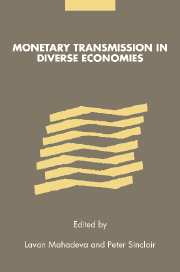Book contents
- Frontmatter
- Contents
- List of figures
- List of tables
- List of contributors
- Acknowledgements
- URL disclaimer
- 1 Introduction: the transmission mechanism and monetary policy
- 2 Are the effects of monetary policy in the euro area greater in recessions than in booms?
- 3 Supply shocks and the ‘natural rate of interest’: an exploration
- 4 Some econometric issues in measuring the monetary transmission mechanism, with an application to developing countries
- 5 Central bank goals, institutional change and monetary policy: evidence from the United States and the United Kingdom
- 6 The transmission mechanism of monetary policy near zero interest rates: the Japanese experience, 1998–2000
- 7 What does the UK's monetary policy and inflation experience tell us about the transmission mechanism?
- 8 Modelling the transmission mechanism of monetary policy
- 9 Empirical evidence for credit effects in the transmission mechanism of the United Kingdom
- 10 Uncovered interest parity with fundamentals: a Brazilian exchange rate forecast model
- 11 Uncovered interest parity and the monetary transmission mechanism
- Bibliography
- Index
5 - Central bank goals, institutional change and monetary policy: evidence from the United States and the United Kingdom
Published online by Cambridge University Press: 22 September 2009
- Frontmatter
- Contents
- List of figures
- List of tables
- List of contributors
- Acknowledgements
- URL disclaimer
- 1 Introduction: the transmission mechanism and monetary policy
- 2 Are the effects of monetary policy in the euro area greater in recessions than in booms?
- 3 Supply shocks and the ‘natural rate of interest’: an exploration
- 4 Some econometric issues in measuring the monetary transmission mechanism, with an application to developing countries
- 5 Central bank goals, institutional change and monetary policy: evidence from the United States and the United Kingdom
- 6 The transmission mechanism of monetary policy near zero interest rates: the Japanese experience, 1998–2000
- 7 What does the UK's monetary policy and inflation experience tell us about the transmission mechanism?
- 8 Modelling the transmission mechanism of monetary policy
- 9 Empirical evidence for credit effects in the transmission mechanism of the United Kingdom
- 10 Uncovered interest parity with fundamentals: a Brazilian exchange rate forecast model
- 11 Uncovered interest parity and the monetary transmission mechanism
- Bibliography
- Index
Summary
Introduction
A considerable empirical literature has emerged on the estimation of policy reaction functions and the identification of the underlying preferences of monetary authorities (see Groeneveld, Koedijk and Kool, 1996; Muscatelli and Tirelli, 1996; Clarida and Gertler, 1997; Clarida, Galí and Gertner, 1998; Favero and Rovelli, 1999; and Muscatelli, Tirelli and Trecroci, 1999). Some of these contributions examine whether recent changes in institutional structure, such as the shift to inflation targeting, have had an impact on the conduct of monetary policy. The evidence is mixed. For instance, Muscatelli, Tirelli and Trecroci (1999) show that there is only slight evidence that the introduction of inflation targeting affected forward-looking policy reaction functions in the United Kingdom, New Zealand, Sweden and Canada. In contrast they find some evidence of policy instability in Japan and the United States in the 1980s and 1990s, even in the absence of institutional change.
Of course one would also expect significant shifts in monetary policy that bring about a reduction in inflation expectations to affect the transmission mechanism of monetary policy. The standard New Keynesian model of aggregate demand and supply, which has been used extensively for policy analysis (see Svensson, 1997; Rudebusch and Svensson, 1999; McCallum and Nelson, 1999a,b; and Rudebusch, 2000), suggests that forward-looking expectations are important on both the demand and the supply side.
- Type
- Chapter
- Information
- Monetary Transmission in Diverse Economies , pp. 100 - 126Publisher: Cambridge University PressPrint publication year: 2002
- 1
- Cited by

